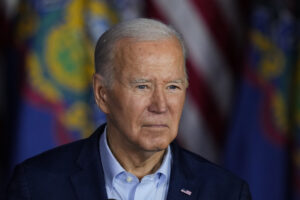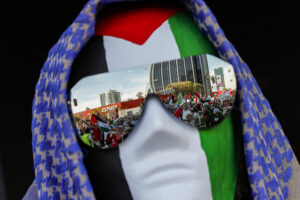Children of the Stone
A fierce 8-year-old Palestinian boy, caught in a famous photograph throwing a rock at an Israeli soldier, grows up to become a great classical violist dedicated to bringing music and musical education to Palestinian children (Above, a detail of the cover of "Children of the Stone," a book reviewed by Tim Riley). Detail from the cover of "Children of the Stone." (Bloomsbury USA)
Detail from the cover of "Children of the Stone." (Bloomsbury USA)
|
To see long excerpts from “Children of the Stone” at Google Books, click here. |
“Children of the Stone: The Power of Music in a Hard Land” A book by Sandy Tolan
On a war-torn street near Ramallah during the first intifada of 1988, a fierce 8-year-old Palestinian threw a stone at an Israeli soldier to protest the previous day’s killing of four workers in Gaza. A photo captured his defiance and ran in a leftist Israeli newspaper. The image quickly seduced the world’s news wires. The boy, Ramzi Hussein Aburedwan, seemed typical of his generation, the “children of the stone” — determined to defy the Israeli occupation and outrun the army using superior backstreet smarts.
Shortly after throwing his stone, Ramzi was handed some maracas by a music teacher at a United Nations elementary school. The teacher opened a cabinet full of musical instruments, pulling out a violin and changing Ramzi’s life. Raised by his grandparents after his mother fled his abusive father, Ramzi determined to open his own music school in Ramallah. Through years of practice, oppression, protest and countless negotiations with Israeli’s border soldiers, he built Al Kamandjati (“the violinist”) Association — an organization dedicated to bringing music and musical education to Palestinian children, particularly those living in refugee camps and villages in Palestine and Lebanon — and toured Europe and the Middle East as a violist with Daniel Barenboim’s West-Eastern Divan Orchestra.
Sandy Tolan’s ambitious narrative, “Children of the Stone: The Power of Music in a Hard Land,” details Ramzi’s struggles against Israel’s brutal occupation and expanding settlements through several scuttled peace processes. Ramzi grows up in the Al Amari refugee camp hearing his grandparents’ stories of their home in Na’ani village, near Tel Aviv, which the British ruled from 1917 to 1948. When the Israeli army conquered the nearby town of Ramle, they trucked Ramzi’s grandparents to an internment camp. Along with 50,000 others (a subset of the total 750,000 displaced Palestinians), the family fled to Ramallah, where the Red Cross helped set up a refugee camp called Al Amari, always planning to return to the coast. Since the 1967 War, however, most of these refugees grew up knowing only night raids and armed checkpoints, murdered relatives (like Ramzi’s brother), tear gas, curfews and festering resentments. Ramzi’s story pits hope against a cascade of conflicts, sympathizing with the occupied (grazing over terrorist elements) as he describes Israel’s encroaching footprint.
Amid these chafing political tensions, Ramzi’s talent and persistence in the face of trauma conveys hope, but never enough. Enough generous musicians invest in Ramzi’s raw talent to carry him to a music school in France, the Conservatoire d’Angers in France’s Loire Valley, then back to the Palestinian school established by Columbia University critic and scholar Edward Said, the National Conservatory. By 2003, Ramzi had raised enough money and a Swiss development deal to launch his own school.
Tolan excels as a dogged reporter, and his musical descriptions amplify his core themes. He describes Ramzi’s rambunctious Rimsky-Korsakov like this: “The speed was no longer beyond him. Again he was transported to the refugee camp during the intifada. Each measure sounded like a sprint down a narrow alley, a cut through a row house, a dash through a neighbor’s front door, a dive through an open window, a frantic climb to the rooftop. Ramzi felt the piece, so it came out naturally.”
Ramzi receives high-level support from two luminary sources: Edward and Mariam Said, and the Israeli-born conductor Daniel Barenboim. The Barenboim-Said Foundation had already started one conservatory in Palestine (the Ma’had), and Barenboim’s Divan Orchestra united Jewish and Arab players for a top-shelf touring ensemble. In this context, the orchestra’s mission seems both grandiose and naive: It performs Western classical music at the highest level to symbolize how enemies working together can create a living fraternity that counters hostilities on the ground.
“How long can the history of anti-Semitism and the Holocaust be used as a fence to exempt Israel from arguments and sanctions against it for its behavior towards the Palestinians?” Said wrote in “The Politics of Dispossession,” effectively stating Tolan’s view. “How long are we going to deny that the cries of the people of Gaza … are directly connected to the policies of the Israeli government and not to the cries of the victims of Nazism?”
The book’s central tension pits the joy of music against the impossibility of a nonpolitical cultural stance in the region. “Music devoid of politics, Ramzi believed, was impossible under occupation. Now, too, politics was impossible for Ramzi without music.” After the United States, the European Union, Russia and the United Nations shunned the democratically elected Hamas in 2006 (the Islamic answer to the PLO), Israel kept investing in more settlements. Even the emergence of the nonviolent Boycott, Divestment and Sanctions (BDS) movement has done little for refugees like Ramzi’s family, including his own son. Ramzi, the boy who threw a stone at an Israeli soldier in protest, eventually walks out on the Divan orchestra over its refusal to publicly condemn the Israeli occupation, returning to Palestine to run his music school.
“Most of the Divan’s Arab musicians had not experienced life under occupation,” Tolan writes. “The Israelis in the Divan, on the other hand, not only knew about the occupation; as soldiers under Israeli’s compulsory military service, many of them had been part of the occupying army. Perhaps this was why ‘they are always uncomfortable when I try to talk to them about it. …’ In the Divan, Ramzi often said, he might play as an equal beside an Israeli on a European stage, but back home, under occupation in Palestine, this same person could be the soldier at a checkpoint, ‘not letting me go teach music.’ ”
Ramzi’s burnout, even as an avid peacemaker, hardly seems extreme. Perhaps Jimmy Carter’s use of the term “apartheid” when talking about Israeli-Palestinian relations won’t sound as controversial after reading Tolan’s devastating account. As Bishop Desmond Tutu said in 2002, “I’ve been very deeply distressed in my visit to the Holy Land. It reminded me so much of what happened to us black people in South Africa. I have seen the humiliation of the Palestinians at checkpoints and roadblocks, suffering like us when young white police officers prevented us from moving about.”
Music may have rescued Ramzi from terrorism or an Israeli jail, or worse. But Tolan seems to wonder whether Barenboim and Said’s cross-cultural harmony actually serves Israeli cynicism. The book ends hanging as any two-state solution all but evaporates. This makes Ramzi’s naiveté heroic yet futile: Tolan barely mentions rockets, tunnels, or the rise of Iran and ISIS extremism during Ramzi’s lifetime. You want to embrace the idea that great music can make a better world, but the future looks only bleak for Ramzi’s hopeful music students.
Your support matters…Independent journalism is under threat and overshadowed by heavily funded mainstream media.
You can help level the playing field. Become a member.
Your tax-deductible contribution keeps us digging beneath the headlines to give you thought-provoking, investigative reporting and analysis that unearths what's really happening- without compromise.
Give today to support our courageous, independent journalists.






You need to be a supporter to comment.
There are currently no responses to this article.
Be the first to respond.